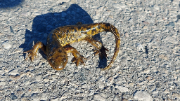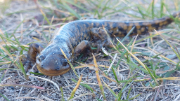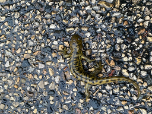Gray Tiger Salamander (Ambystoma mavortium diaboli)
Description: The Gray Tiger Salamander is a large salamander. It can grow to be 33 cm long. They are usually an olive-green colour with dark patches or stripes on top and a lighter coloured belly. Some can be dark gray all over.
Habitat: Habitat is diverse - it includes bottom land deciduous forests, coniferous forests and woodlands, open fields and bushy areas, alpine and subalpine meadow, grasslands, semideserts and deserts, and (rarely) in streams. Sandy or friable soils make for good breeding ground.
Found in these States:
ND
Diet: These salamanders eat insects and other small invertebrates such as spiders, worms and snails. Gray Tiger Salamanders grow large enough that they might even eat small frogs. The larvae eat insects and other small water animals.
Reproduction: Gray Tiger Salamanders mate and lay their eggs in deep ponds from late March into April. The female lays about 100 eggs. She lays them one at a time or in small groups on rocks, plants or sticks on the bottom of the pond. It takes 20 days for the eggs to hatch. The young can change to adult shape and leave the pond in late August or early September, about 60 days after hatching. They are about 10 to 15 cm long when they change to adult shape.
Sometimes the young salamanders take more than one summer to grow big enough to change to adult shape. They can stay in the pond over winter and keep growing through the next summer. It can take nearly 400 days to go from being an egg to changing to adult form
Status: Listed as Least Concern in view of the large extent of occurrence, large number of subpopulations and localities, large population size and use of a wide range of habitats.
»» Kingdom: Animalia - Animals
»» Phylum: Chordata - Chordates
»» Subphylum: Vertebrata - Vertebrates
»» Class: Amphibia - (Amphibians)
»» Order: Caudata - Salamanders
»» Family: Salamandridae - Newts
»» Subfamily: Pleurodelinae - Pleurodeline Newts
»» Genus: Ambystoma
»» Species: Ambystoma mavortium - Western Tiger Salamanders
»» Subspecies: Ambystoma mavortium diaboli - Gray Tiger Salamander
This article uses material from the Wikipedia article "Barred Tiger Salamander", which is released under the Creative Commons Attribution-Share-Alike License 3.0. Content may have been omitted from the original, but no content has been changed or extended.
|













